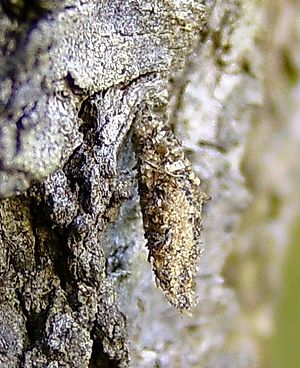Triangular dwarf sack carrier
| Triangular dwarf sack carrier | ||||||||||||
|---|---|---|---|---|---|---|---|---|---|---|---|---|

Caterpillar sack of the triangular dwarf sack carrier |
||||||||||||
| Systematics | ||||||||||||
|
||||||||||||
| Scientific name | ||||||||||||
| Dahlica triquetrella | ||||||||||||
| ( Huebner , 1813) |
The triangular dwarf sack carrier ( Dahlica triquetrella ) is a butterfly from the family of the real sack carrier (Psychidae). The species occurs in both bisexual and diploid or tetraploid parthenogenetic forms.
features
butterfly
The adult animals are characterized by a clear sexual dimorphism . The wings of the males are narrow and elongated, have a wingspan of about 9 to 13 millimeters, are gray-brown in color and show a pattern of many whitish spots. There are relatively short fringes on the edge of the wing. Females resemble maggots , are brown in color, have a very small head, a cylindrical body and a tuft of white-gray anus wool on the abdomen. They do not have wings, but have well developed legs.
Caterpillar
The caterpillars are yellowish in color, have a dark amber-yellow head and breast shields. You spin yourself into a sack-like living tube. Their shape is strikingly triangular, about 4 to 6 millimeters long and tapers at both ends, the ventral side is flat. The caterpillar attaches tiny plant particles and grains of sand to the outside. Particularly characteristic, however, is the attachment of small pieces of chitin from other insects, especially to the front part of the tube.
Distribution and occurrence
Bisexual tribes come in isolated colonies in parts of the Alps and the Swiss Jura on mountain peaks that protruded from the ice mass without glaciers during the Riss and Würme Ice Age , the so-called Nunatakkern as well as in the Reichswald near Nuremberg , in the Danube Valley between Passau and Linz , the Adelegg and heights near Trieste . Parthenogenic strains are distributed from England eastwards through Central and Eastern Europe including the Alps to Russia , and also in separate populations in many areas of Northern, Western and Southern Europe. The animals inhabit a wide variety of habitats. These include deciduous and coniferous forests, shrub landscapes and rocky slopes.
Way of life
The males mainly fly in April and May. During the entire caterpillar stage, the caterpillar remains in its protective cover and also pupates in it. The male moth leaves the caterpillar sac and seeks out the flightless female, who sits on the outside of the sac tube, to mate. Both sexes have a very short lifespan, often only a few hours. Parthenogenetic females begin to lay eggs shortly after hatching. The caterpillars prefer to feed on the lichen species Lepraria incana . The larval sac tube of the animals is attached to trunks, posts and walls at a height of usually one to two meters.
Danger
In Germany, the bisexual form can only be found in Bavaria and Baden-Württemberg and is classified on the Red List of Threatened Species as a species with geographical restrictions. The parthenogenic form is common in certain areas and is not considered to be endangered.
swell
Individual evidence
- ↑ Walter Forster, Theodor A. Wohlfahrt: The butterflies of Central Europe. Volume 3: Weirdos and Swarmers. (Bombyces and Sphinges). Franckh'sche Verlagshandlung, Stuttgart 1960, DNB 456642196 .
- ^ A b Günter Ebert: The butterflies of Baden-Württemberg . 1st edition. tape 3 . Moths I. Root borer (Hepialidae), wood borer (Cossidae), ram (Zygaenidae), snail moth (Limacodidae), sack bearer (Psychidae), window stain (Thyrididae) . Ulmer, Stuttgart (Hohenheim) 1994, ISBN 3-8001-3472-1 .
- ↑ Federal Agency for Nature Conservation (Ed.): Red List of Endangered Animals in Germany . Landwirtschaftsverlag, Münster 1998, ISBN 3-89624-110-9 .
literature
- Günter Ebert: The butterflies of Baden-Württemberg . 1st edition. tape 3 . Moths I. Root borer (Hepialidae), wood borer (Cossidae), ram (Zygaenidae), snail moth (Limacodidae), sack bearer (Psychidae), window stain (Thyrididae) . Ulmer, Stuttgart (Hohenheim) 1994, ISBN 3-8001-3472-1 .
- Walter Forster , Theodor A. Wohlfahrt : The butterflies of Central Europe. Volume 3: Weirdos and Swarmers. (Bombyces and Sphinges). Franckh'sche Verlagshandlung, Stuttgart 1960, DNB 456642196 .
Web links
- www.lepiforum.de 1 photos (bisex. form)
- www.lepiforum.de 2 photos (parth. form)
- www.schmetterlinge-deutschlands.de Endangerment (bisex. form)
- Dahlica triquetrella at Fauna Europaea